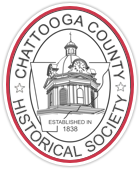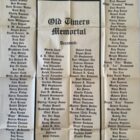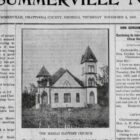Growing up at Riversdale in the 1910s by Evelyn K. Stephenson
Stories about Life in the Early 1900s
as told by Evelyn Kellett Stephenson
( reprinted from the 2005 quarterly)

Riversdale 1906 L to R, Eliza and John Wesley Rivers,Sara Thurman,Gordon and Lillie Kellett (porch) and John and Hillary Rivers
I’m sure the way we lived at Riversdale when I was growing up would seem like a hard life compared with the way people live today. There were no modern conveniences; our house was heated by open fireplaces in which logs were burned. The logs were cut from woods from on the place. We cooked on stoves that burned wood, too. This wood had to be brought into the house each night. Ashes from these fires had to be carried out each day.
Our water system consisted of a well of fresh, sweet water with a windlass, a rope and bucket. We drew our water up with a bucket full at a time. Near the well, inside the barn lot, was a long trough for watering the stock when they brought them in from the fields. There was a smaller wooden trough that came up to the well from a larger one. Water was drawn from the well, poured into the smaller one and it ran into the big one. There was a pond in the pasture where the stock drank when not at work.
We had an outdoor toilet that was sort of cool in the winter. We had a wash bench down under the big cedar just west of the well. An iron wash pot stood nearby; on wash days we filled the pot with water, built a fire around it and left it for awhile for the water to heat, on the bench were the wash tubs. While the pot the heating, we filled the rinsing tubs with water. A soon as the water was warm enough, we filled one tub with the warm water, then added some more to the pot and started scrubbing the clothes in the tub with the warm water on a washboard. We used Octagon soap. We put the white things in the pot with some Gold Dust washing power and boiled them for awhile. After rinsing everything though the two tubs of clear water, our clothes were clean and sweet smelling. Of course, we hung them on a line to dry. That was the only modern thing we had. They were dried by “solar power.” Washing was sometimes an all day job. This was so different from stuffing clothes in an automatic washer, then into a dryer.

The wife of a tenant farmer scrubs laundry on a washboard in a wooden tub, while a dirt-covered toddler plays with an empty bottle on the ground, North Carolina, 1930s. Laundry hangs on a clothesline in the yard. (Photo by American Stock/Getty Images)
We had an icebox with a compartment in the top to keep the ice. Below that was another compartment that had shelves for food. There was a drain pipe that ran from the ice chamber down to the floor. A pan was kept under the pipe to catch the water as the ice melted. It had to be emptied twice a day. We didn’t have ice all the time; someone had to go to town to get it, and so we had it only on special occasions. Without ice, the main problem was keeping milk cool. Mama had a tub on the back porch up in the corner where it was shady. As soon as the milk was brought from the barn in the morning, she would strain it into a container and put it into the tub and then we would fill the tub with cold water from the well. Later, after she had churned the milk she would put a container of buttermilk in the tub. After four o’clock in the afternoon, she would empty the tub and we would fill it again with fresh cold water. At meal time, the milk was nice and cool, not ice cold like we have it today, but far from being hot. Some people had a spring nearby, and they would put their milk into the spring.
We ironed our clothes with heavy flat irons or as some called them sad-irons. They were heated on the wood stove. It was a hot job in the summer but we had no drip-dry or permanent press clothes in those days.
There were many other facets of farm life, when I grew up, that would seem strange today. So many things were still being done the same way that had prevailed for many years. It all seems so normal and everyday to me, that I have a hard time remembering what might prove interesting today. For one thing, we had no paved roads. The roads were narrow, dusty in the dry weather and almost impassable in the winter. We used kerosene lamps for lighting. That made another job as lamp chimneys should be washed and polished each day. The lamp had to filled each day and the wicks trimmed if we had good light.
Things were not much better in Summerville. The city streets had white chert on them. It was a little hard on the eyes on sunny days but better than the mud of the country roads. There were no electricity or water systems. Most people drew their water from wells just as we did at Riversday. When Uncle John Strange built this house on Washington Street in 1914, he had a water system put in when it was built. He had a huge wood tank set up high on four cedar posts. The well was in the back porch. There was a small gasoline engine that was cranked up by hand and let run for a while each day to fill the tank. He had a bathroom and had a sink in the kitchen. Hot water was furnished by a big tank that was heated by the cook stove. There was a hydrant in the front yard and one in the back, and water was piped to the wash shed so “Lissy” would have water for washing clothes. A few others in town had similar systems on East Washington street. I remember the Henleys, Edmondsons, Selmans, and Bellahs. Others had wells and drew their water with buckets as we did on the farm.
Soon after Word War 1, the Taylors set up a water system for the town. Uncle John joined up with it and sold the little engine and tank. After that we paid two dollars per month for water. I am not sure who brought electricity to the town, but it was around 1918. The street lights in town were on poles in a row right down the center of Commerce Street. Georgia Power bought out the town system in 1924, but power did not come to the rural areas until after World War II.
King Cotton
In the early 1900s, cotton was still king in the South. Chattooga and surrounding counties were a region of small family-size farms. Situated as we are in the last foothills of the Blue Ridge Mountains, the farms were hilly and fields small. This was the era of the sharecropper. Most of the farms were worked by the owners. Where there was more land that the owners could work, the rest was rented to a sharecropper. The sharecroppers were a class of people who owned nothing but the necessities for housekeeping and sometimes a cow and chickens. Most farms of average size had from one to two tenet houses. To say the least, the houses lacked much in the way of comfort. Over the years, there had been many such houses in different places at Riversdale. I can remember but two, the cabin at Red Hill and the Cody house. The others had gone with the wind before I came along,, although I know where several of them stood.
When you rented to a sharecropper, you agreed to furnish him a house, garden, firewood and the stock to work the fields. If he didn’t have the money (who did?) to buy supplies while making the crop, you established credit for him at a grocery store in town. Sometimes the storekeeper would not sell them anything without an order signed by the farm owner. If, when the cotton was sold, he didn’t have enough to pay his bill, of course you were stuck with the balance. In that case, there was some “moving on” done. In return for this, the sharecropper and his family worked the crops. When gathered, the owner got half of what he made. The ones who lived at Riversdale worked on these terms, for we had the stock. We rented Castleberry place to people who owned their own stock and received from them 1/3 of the corn, hay and feed stuff and 1/4 of the cotton they grew. They didn’t need credit. In later years (1922) Aunt Tavia rented to J.M. “Bud” Reynolds. He had his stock, as there was no barn at the Cody house. The cabin at Red Hill was torn down and the logs carried down there. They were used to build a small barn with two stalls for his mules and one for his cow and corn crib. After the Reynolds went to Texas in 1926, we rented to people who had their own stock and could furnish it for themselves.
This was a hard life for the sharecropper, hard work and never very much to show for it. It was hard on the woman for they worked in the fields, sometimes really doing more than the men because they had the house to keep. Of course, there were sharecroppers AND sharecroppers; some didn’t know how to plan for a day ahead. I suppose they thought there would always be a house and a little food. They didn’t know how to make the most of the little they had. Some would burn up the doorsteps before they would go to the woods and cut free fire wood. One owner told me he had a family on his places that had a lot of small children and not much to eat. They had no cow. He had a milk cow he didn’t need. He loaned it to them so the children would have plenty of milk and butter. He said the parents were so lazy they wouldn’t milk the cow often enough and her milk would dry up. It’s hard to help people who won’t help themselves.
Then– there were the more industrious; they knew how to make the most of what they had and to try to add to it. Of course, it took a lot of hard work. Their women knew how to sew nicely, cook good food, keep the house clean, as well as can and preserve fruits and vegetables for winter use. They raised enough Irish and sweet potatoes to last through the winter. They raised a hog or two for the meat and with them a cow and chickens; they had a good living even though they worked someone else’s land. They didn’t have much cash money but had plenty to eat. Some of these in time, came to own their own land.
The sharecropping system might have lasted longer, had it not been for the boll weevil, which arrived in our area sometime in the early 1920s. They came in full force and played havoc with the cotton crop. Farmers did their best to cope with them but did not have much success. They used poison but as this was applied to the plants with a dusting machine using “man power.” It was a hard-hit tedious job that was never successful in eradicating the pests. They always showed up again next year.
Farmers began to realize they couldn’t go on depending on having just one crop that brought in income. Cotton was a crop that brought in money in the fall. Most of the rest of the year was spent in growing it. They began to look for a more diversified system that would bring income at different times during the year.
In 1929, the Great Depression hit the country. For a few years, people thought more of managing to survive than making money. No one had any. The renters were glad to stay on the farms for they had free firewood, house, and a place to grow food. The owners were glad to have their fields in cultivation and for the little rent they received. As the textile mills began to lay off their workers, many of them went back to the country, living in most anything that had a roof and a place to grow food. World War II came along and with it, jobs began to open up. By the end of the war in 1945, most of those who had worked as renters on the farm had jobs in the cotton mills and other industries. The farm owners had begun to raise cattle, chickens for broilers and for eggs, so most of the fields that had grown cotton for so long were turned into pasture land.
Now in this area at least, cotton is a thing of the past. The little family farm, as we knew it when I grew up, is gone. Many people own small farms and live on them but they have jobs elsewhere. They live on the farm because they enjoy it. Farming now is big business, done with modern machinery on farms of many acres. The little farm can’t compete with that, no more than the small grocery store can compete with the big chains.
I was born and brought up in the days when cotton was a way of life. To me it was beautiful from the time of planting until the last white lock was picked in the fall. There is nothing prettier than a field of cotton when it first comes up out of the ground. The long rows of green falling the contour of the land are beautiful and so it is all through the different growth stages.
There may be others who differ with me. I never had to hoe it or pick it in the hot sun, but is sure was pretty to me, and I loved to see it grown Maybe I learned to love it from Hubbie; he was all “cotton man.”
I said I could go back and live like we used to without any trouble. I think I could accept all of it gracefully if it wasn’t for that WASHBOARD! From the time I can remember, we did have one modern convenience, the telephone. I don’t remember a time without it.















